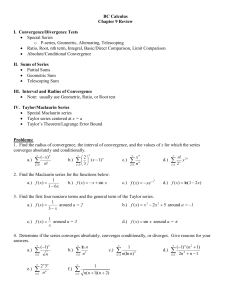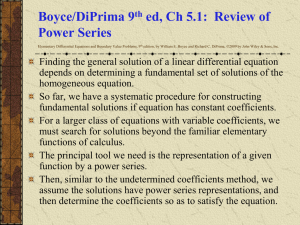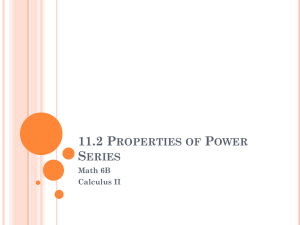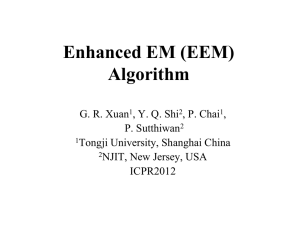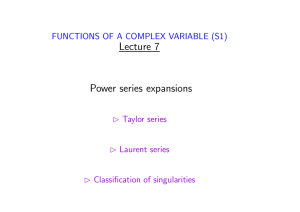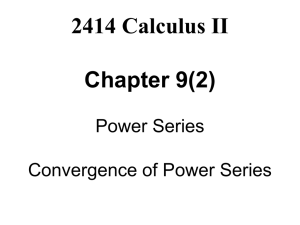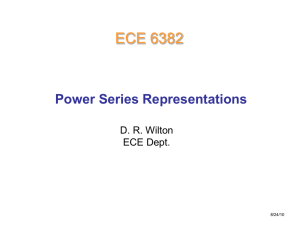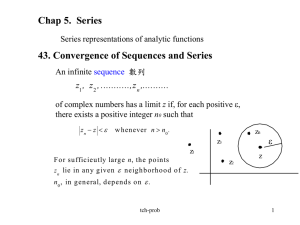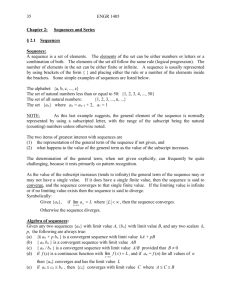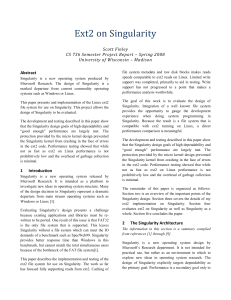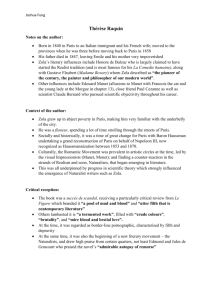Example
advertisement
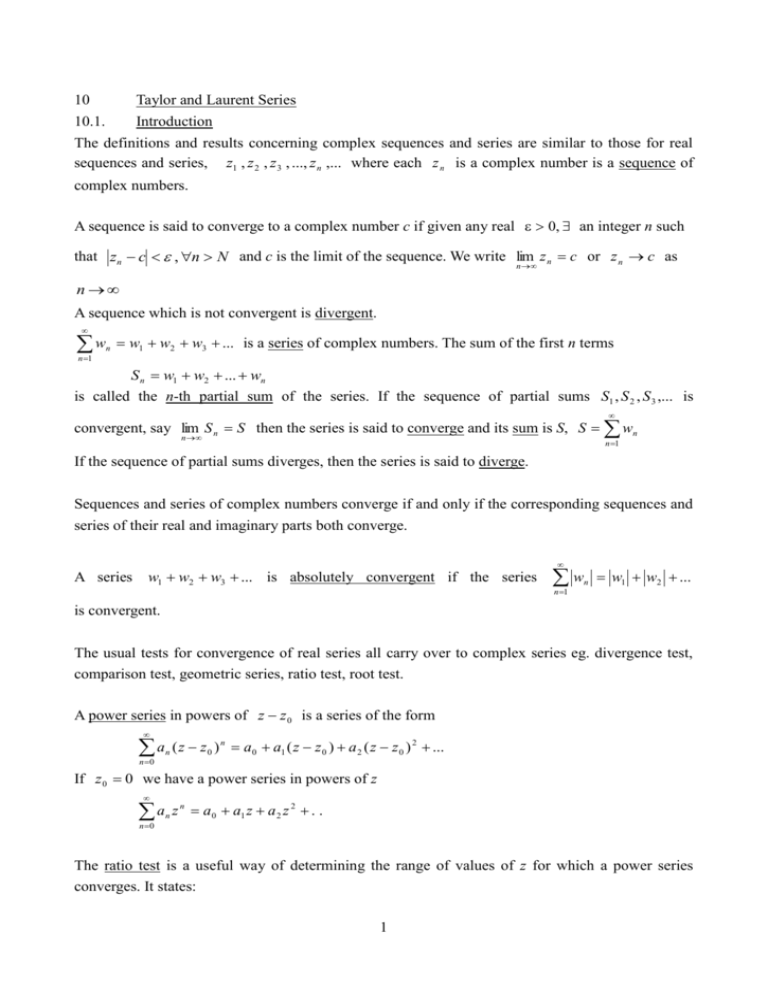
10 Taylor and Laurent Series 10.1. Introduction The definitions and results concerning complex sequences and series are similar to those for real sequences and series, z1 , z 2 , z 3 , ..., z n ,... where each z n is a complex number is a sequence of complex numbers. A sequence is said to converge to a complex number c if given any real 0, an integer n such that zn c , n N and c is the limit of the sequence. We write lim z n c or z n c as n n A sequence which is not convergent is divergent. w n 1 n w1 w2 w3 ... is a series of complex numbers. The sum of the first n terms S n w1 w2 ... wn is called the n-th partial sum of the series. If the sequence of partial sums S1 , S 2 , S 3 ,... is convergent, say lim S n S then the series is said to converge and its sum is S, S wn n n 1 If the sequence of partial sums diverges, then the series is said to diverge. Sequences and series of complex numbers converge if and only if the corresponding sequences and series of their real and imaginary parts both converge. A series w1 w2 w3 ... is absolutely convergent if the series w n 1 n w1 w2 ... is convergent. The usual tests for convergence of real series all carry over to complex series eg. divergence test, comparison test, geometric series, ratio test, root test. A power series in powers of z z 0 is a series of the form a n 0 n ( z z 0 ) n a 0 a1 ( z z 0 ) a 2 ( z z 0 ) 2 ... If z 0 0 we have a power series in powers of z a n 0 n z n a 0 a1 z a 2 z 2 . . . The ratio test is a useful way of determining the range of values of z for which a power series converges. It states: 1 a n 0 n ( z z0 ) n converges absolutely if a n1 ( z z 0 ) n1 1 n a ( z z ) n n 0 lim and diverges if this limit is >1. If the limit = 1 or does not exist, no conclusion can be drawn. Now, an1 ( z z0 ) n1 a lim n1 z z0 n a ( z z ) n n a n 0 n lim an then the test gives n a n 1 If R lim (i) for z z 0 R the series converges absolutely (ii) for z z 0 R the series diverges (iii) for z z 0 R no conclusion can be drawn Geometrically z z 0 R is an open disc with centre z 0 and radius R. R is called the radius of convergence of the power series. The circle z z 0 R inside which the power series is absolutely convergent is known as the circle of convergence. Example The geometric series z n 1 z z 2 z 3 ... n 0 converges absolutely for z 1 and diverges for z 1 . R = 1. Example zn z2 z3 1 z ... (which may be used to define e z ) has R and is 2! 3! n 0 n! absolutely convergent for all finite z. The series Example The series 2 n! z 1 z 2! z 2 3! z 3 ... n n 0 has R = 0 and converges only at z = 0. 10.2. Taylor series The complex Taylor series is a generalization of the real variable series. If f(z) is analytic in a region R and z 0 R then for z R, f ( z ) may be represented as f (n) ( z0 ) ( z z0 ) n n! n 0 f "( z0 ) f ( z 0 ) f ' ( z 0 )( z z 0 ) ( z z 0 ) 2 ... 2! This series is called the Taylor series for f(z) about z 0 . The radius of convergence of this series is the distance from z 0 to the nearest singularity (where f ( z) f(z) is not analytic) of f(z). The power series of f(z) about z 0 is unique and hence any method of calculating the coefficients will always give the Taylor series. Example ez n 0 zn z2 1 z ... n! 2! (1) n z 2 n 1 z3 z5 z ... 3! 5! n 0 ( 2n 1)! sin z (1) n z 2 n z2 z4 1 ... (2n)! 2! 4! n 0 cos z are all absolutely convergent for all finite z, i.e. R . Example (1 z ) p 1 pz p( p 1) 2 p( p 1)...( p n 1) n z ... z ... 2! n! Is absolutely convergent for z 1 i.e. R = 1. This is the Binomial Theorem and is often used to find a Taylor series. Example Consider the Taylor series of f ( z ) 1 about z2 3 (i) z 0 0 , 1 (i) z2 (ii) z 0 1 1 z 2(1 ) 2 1 z (1 ) 1 2 2 1 z z z (1 ( ) 2 ( ) 3 ...) 2 2 2 2 2 3 1 1 z z z .... z2 2 4 8 16 1 1 1 (ii) z 2 ( z 1) 1 w 1 1 (1 w) 1 w 1 (1 w w 2 w 3 ...) for z 2 for z 2 for w 1 1 1 ( z 1) ( z 1) 2 ( z 1) 3 ... for z 1 z2 Im z Notice that in each case the circle of convergence extends as for as the point z = 2 where f(z) has a singularity. 0 1 2 Re z 10.3. Laurent Series The circle of convergence of a Taylor series is determine by the singularities of f(z). For example. The Taylor series for f(z) = 1/(z-2) about z 0 0 converges only within the circle z 2 even though f(z) is only singular at one point z = 2. It is however possible to obtain other series representation of functions f(z). Example Consider f ( z ) e z / z . A Taylor series for f(z) exists about any point z z 0 with z 0 0 for which the circle of convergence is | z z 0 || z 0 | 1 (1 z z 2 / 2! z 3 / 3!...) 1 / z 1 z / 2! z 2 / 3!... z We have a series (not Taylor) representation of f(z) which converges for 0 | z | . If, however, we write e z / z Example Consider f(z) =1/(z-2) which has a singularity at z = 2. Let w = z-1, then 4 1 1 w 1 w(1 1 / w) 1 (1 1 / w 1 / w 2 1 / w 3 ...) w 1 /( z 2) 1 /( z 1) 1 /( z 1) 2 1 /( z 1) 3 ... 1 /( z 2) for | 1 / w | 1 i.e. | w | 1 which is a series representation which converges for | z 1 | 1 . This is the region exterior to the circle of convergence for the Taylor series about z 0 1 . Both of these series contain negative powers of ( z z 0 ) and are known as Laurent series. If f(z) is analytic on and in the region between two concentric circles C1 and C2 with centre z 0 , then f(z) may be represented by the Laurent series f ( z) a n n ( z z0 ) n a0 a1 ( z z 0 ) a 2 ( z z 0 ) 2 ... a 1 a2 ... z z0 ( z z0 ) 2 This series converges for any point z in the open annulus between C1 and C2 Im z C C1 C2 The coefficients of the z0 series are given by 1 f ( z) an dz 2j C ( z 0 ) n 1 Re z the annulus where C is any closed contour which lies in and encloses C2 . However the coefficients are rarely calculated using this integral, as the examples illustrate. The part of the series a 0 a1 ( z z 0 ) a 2 ( z z 0 ) 2 ... is called the analytic part of the Laurent series, while the part with the inverse powers of is called the principal part. If the principal part is zero, the Laurent series reduces to a Taylor series. This will be the case if f(z) is analytic inside C2 . If z z 0 is the only singular point in C2 then the Laurent series will converge for all z within C1 except at z z 0 . The Laurent series of f(z) is unique in its annulus of convergence. However f(z) may have different Laurent series in different annuli with the same centre. Example 5 Find Laurent series for f ( z ) f ( z) 1 about z 0 1 . 1 z2 1 ( z 1)( z 1) Now 1 1 1 where w z 1 z 1 2 ( z 1) 2 w 1 1 1 w (1 ) 1 w 2 2 2 1 2 1 w w 2 w3 w (1 ...) for 1 2 2 4 8 2 1 ( z 1) ( z 1) 2 ( z 1) 3 (1 ...) 2 2 4 8 1/ 2 1 1 1 f ( z) ( z 1) ( z 1) 2 ... z 1 4 8 16 which converges for 0 | z-1| 2 . Similarly 1 1 1 z 1 2 ( z 1) ( z 1) 1 1 2 z 1 1 wher e w z 1 2 w(1 ) w 1 2 4 8 2 (1 2 3 ...) for 1 w w w w w 1 2 4 8 .... for z 1 2 2 3 z 1 ( z 1) ( z 1) ( z 1) 4 1 2 4 f ( z) ... 2 3 ( z 1) ( z 1) ( z 1) 4 which converges for z 1 2 . Im z Note that f(z) has singularties at z 1 . For n expansion about z = 1, the singularity at z = -1 determines the limit of the region of convergence for each series. 10.4. -1 Classification of Singularities 6 0 1 3 Re z f(z) has an isolated singularity at z z 0 if there is no other singularity within a small neighborhood of z 0 . Otherwise z 0 is a non-isolated singularity. It is possible to determine the nature of the isolated singularities of f(z) by looking at its Laurent Series a a2 f ( z ) a 0 a1 ( z z 0 ) a 2 ( z z 0 ) 2 ... 1 ... z z0 ( z z0 ) 2 analytic part (i) principal part If the principal part is zero, the Laurent series reduces to a Taylor series. If also, a0 a1 ... an1 0 then f ( z ) a n ( z z n ) n a n 1 ( z z n ) n 1 ... and f(z) is said to have a zero of order n at z z 0 . (ii) If the principal part is such that it has only a finite number of terms i.e. an1 an1 ... 0 but a n 0 , an a1 a2 ... 2 z z0 ( z z0 ) ( z z0 ) n then f(z) is said to have a pole of order n at z z 0 . If n = 1, f(z) is said to have f ( z ) a0 a1 ( z z 0 ) ... a simple pole at z. (iii) If the principal part has an infinite number of terms then z z 0 is said to be an essential singularity. Example (i) (ii) ez 1 z z2 1 ... z z 2! 3! has a simple pole at z = 0. 0 z 1 1/ 2 1 1 1 ( z 1) ( z 1) 2 ... 2 1 z z 1 4 8 16 0 z-1 2 has a simple pole at z = 1 (and another at z = -1) Note that we must use the Laurent series that converges in a region of the form 0 | z z 0 | R in determining the kind f singularity at z z 0 . Using the series 1 1 2 4 ... 2 2 z 1 ( z 1) 1 z ( z 1) 3 for | z 1 | 2 is not allowed (this would indicate an essential singularity!). 1 1 (iii) z e z 2 1 ... 2 1! z 2! z 1 1 1 z2 z ... 2 3! z 4! z 2 has an essential singularity at z = 0. 2 1 z | z | 0 In practice poles and zeros of f(z) are located and classified by inspection rather than finding its Laurent series. 7 Example f ( z) ( z 3 j) 2 z ( z j) 3 ( z 1) 4 has a zero of order 2 at z = 3j, a simple pole at z = 0, a pole of order 3 at z = -j and a pole of order 4 at z = 1. f(z) is not defined at a point z z 0 but lim f ( z 0 ) exists, then z z 0 is called a z z0 removable singularity and f(z) at z z 0 is defined as the above limit. Example sin z z2 z4 z6 f ( z) 1 ... z 3! 5! 7! is not defined at z = 0. However lim f ( z ) 1 and we may define f (0) 1, z 0 0 is a removable z 0 singularity. 8
